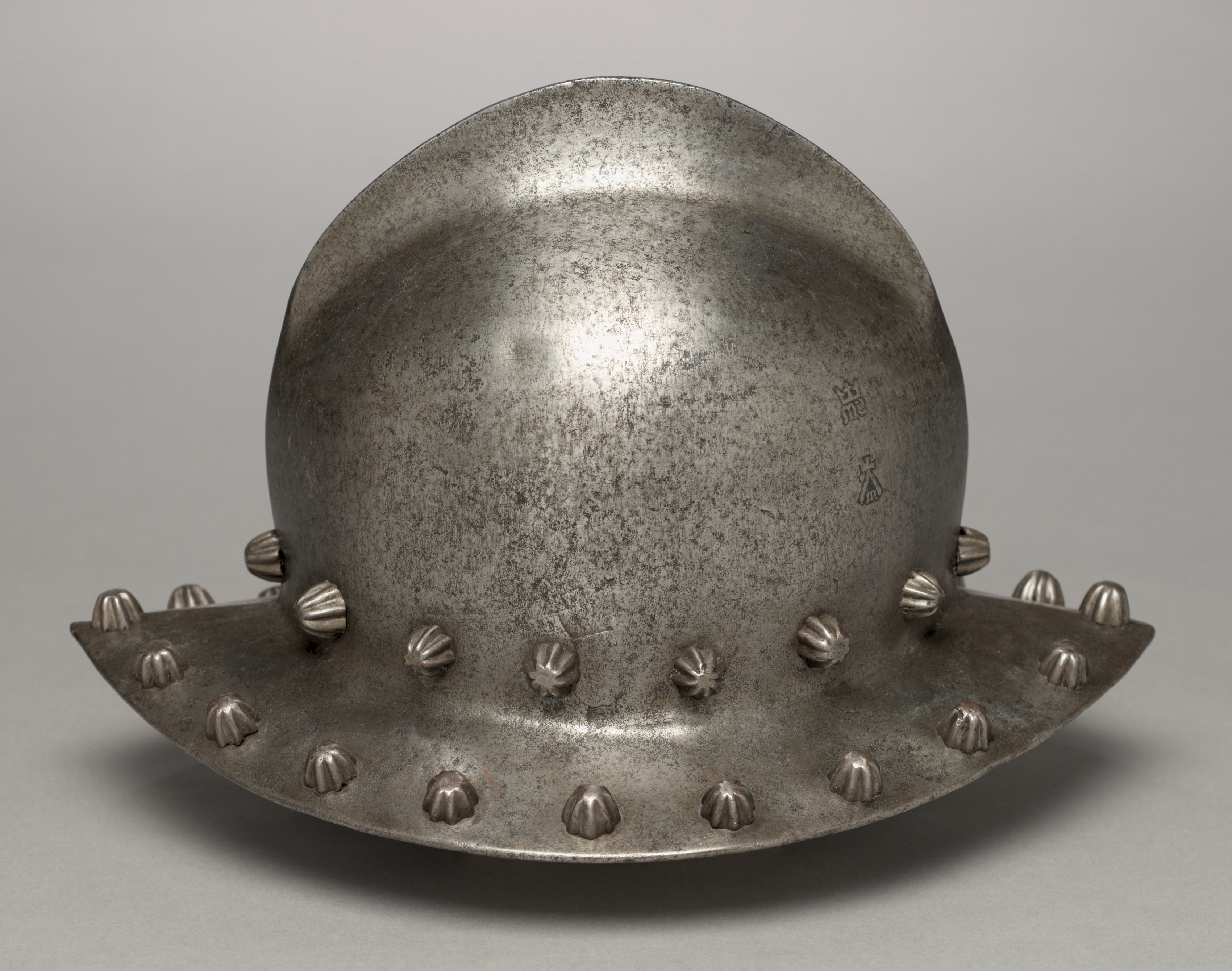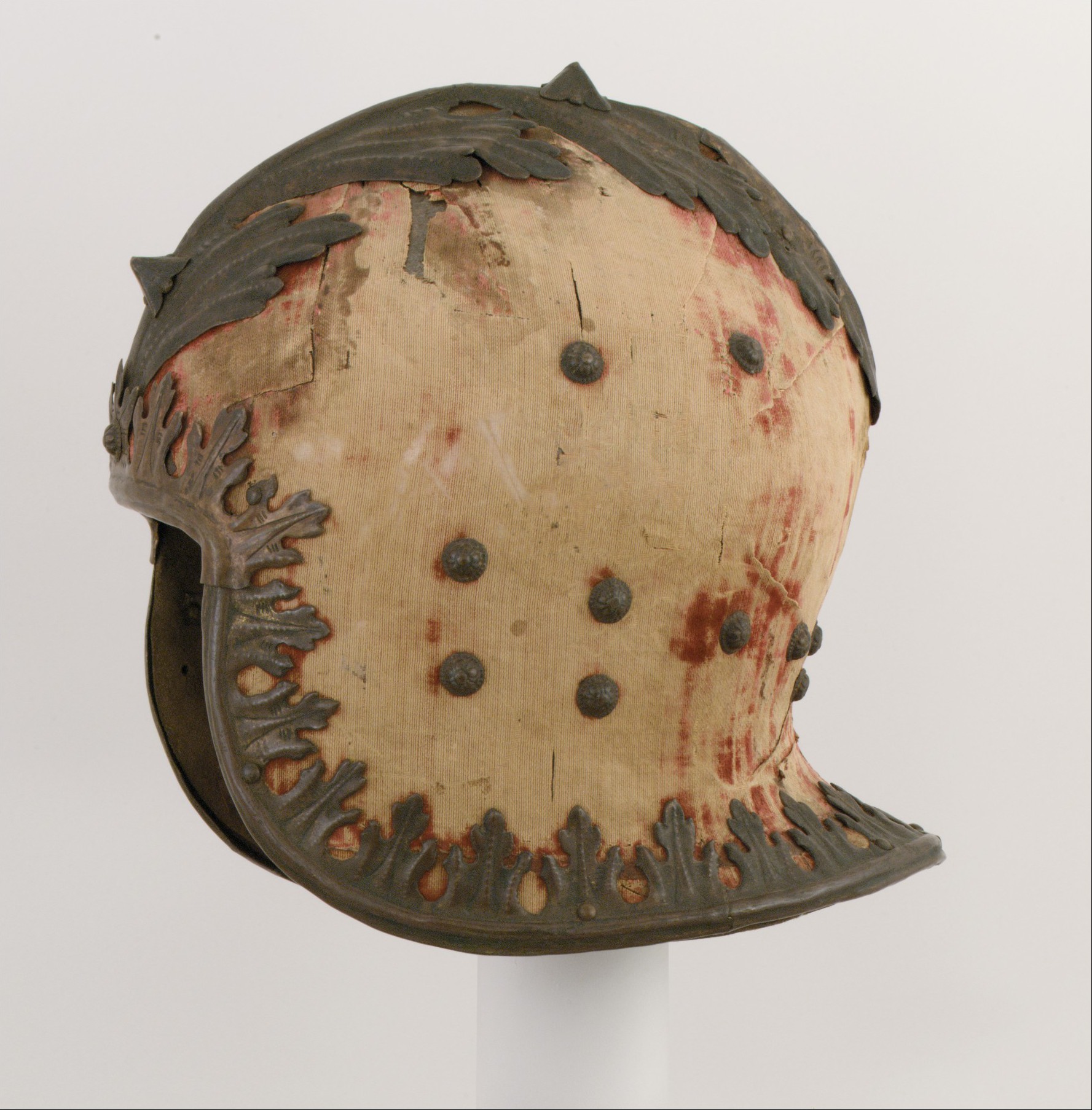|
Chapel De Fer
A kettle hat, also known as a war hat, is a type of helmet made of iron or steel in the shape of a brimmed hat. There are many design variations. The only common element is a wide brim that afforded extra protection to the wearer. It gained its common English language name from its resemblance to a metal cooking pot (the original meaning of ''kettle''). The kettle hat was common all over Medieval Europe. It was called ''Eisenhut'' in German and ''chapel de fer'' in French (both names mean "iron hat" in English). Characteristics and use Though similar brimmed helmets are depicted in illustrations of the Carolingian period, their use seems to have disappeared soon after. In the late 12th century, alongside the development of the enclosed helmet, the brimmed helmet makes a reappearance in Western Europe. Also in the 12th century the brimmed helmet begins to be depicted in Byzantine art, and it has been suggested that it was a Byzantine development. Early examples were made in the ... [...More Info...] [...Related Items...] OR: [Wikipedia] [Google] [Baidu] |
Pickelhaube
The ( pl. ; from german: Pickel, lit=point' or 'pickaxe, and , , a general word for "headgear"), also , is a spiked helmet that was worn in the 19th and 20th centuries by Prussian and German military officers, firefighters and police. Although it is typically associated with the Prussian Army, which adopted it in 1842–43, the helmet was widely imitated by other armies during that period. It is still worn today as part of ceremonial wear in the militaries of certain countries, such as Sweden, Chile, and Colombia. History Origins The Pickelhaube was originally designed in 1842 by King Frederick William IV of Prussia, perhaps as a copy of similar helmets that were adopted at the same time by the Russian military. It is not clear whether this was a case of imitation, parallel invention, or if both were based on the earlier Napoleonic cuirassier. The early Russian type (known as "The Helmet of Yaroslav Mudry") was also used by cavalry, which had used the spike as a holder for ... [...More Info...] [...Related Items...] OR: [Wikipedia] [Google] [Baidu] |
Sallet
The sallet (also called ''celata,'' ''salade'' and ''schaller'') was a combat helmet that replaced the bascinet in Italy, western and northern Europe and Hungary during the mid-15th century. In Italy, France and England the armet helmet was also popular, but in Germany the sallet became almost universal. Origins The origin of the sallet seems to have been in Italy, where the term ''celata'' is first recorded in an inventory of the arms and armour of the Gonzaga family dated to 1407. In essence, the earliest sallets were a variant of the bascinet, intended to be worn without an aventail or visor. To protect the face and neck, left exposed by abandonment of the visor and aventail, the rear was curved out into a flange to protect the neck, and the sides of the helmet were drawn forward below the level of the eyes to protect the cheeks. The latter development was most pronounced in the barbute or ''barbuta,'' a variation of the sallet that adopted elements of Classical Corinthian hel ... [...More Info...] [...Related Items...] OR: [Wikipedia] [Google] [Baidu] |
Zuckerman Helmet
The Zuckerman helmet, officially designated the Civilian Protective Helmet, was a British helmet designed for use by civil defence organisations and the general public during World War II. It was researched and designed by Solly Zuckerman, Derman Christopherson and Hugh Cairns. Background Zuckerman and Cairns first started looking into a design for a helmet to aid civil defence in the mid-1940. Their aim was to provide a helmet that could deal with impact from falling and flying masonry and provide more coverage for the head and the neck areas. After the War Office accepted their design, the ''Civilian Protective Helmet'' went into circulation in December 1940 and throughout 1941, the vast majority therefore being dated 1941. Production Helmets were made from pressed mild steel or manganese steel (known for its impact resistance) in two sizes only and sometimes marked with either M (medium) or L (large) on the inside of the brim. The design of the high dome was to allow the helm ... [...More Info...] [...Related Items...] OR: [Wikipedia] [Google] [Baidu] |
Canada
Canada is a country in North America. Its ten provinces and three territories extend from the Atlantic Ocean to the Pacific Ocean and northward into the Arctic Ocean, covering over , making it the world's second-largest country by total area. Its southern and western border with the United States, stretching , is the world's longest binational land border. Canada's capital is Ottawa, and its three largest metropolitan areas are Toronto, Montreal, and Vancouver. Indigenous peoples have continuously inhabited what is now Canada for thousands of years. Beginning in the 16th century, British and French expeditions explored and later settled along the Atlantic coast. As a consequence of various armed conflicts, France ceded nearly all of its colonies in North America in 1763. In 1867, with the union of three British North American colonies through Confederation, Canada was formed as a federal dominion of four provinces. This began an accretion of provinces an ... [...More Info...] [...Related Items...] OR: [Wikipedia] [Google] [Baidu] |
Australia
Australia, officially the Commonwealth of Australia, is a Sovereign state, sovereign country comprising the mainland of the Australia (continent), Australian continent, the island of Tasmania, and numerous List of islands of Australia, smaller islands. With an area of , Australia is the largest country by area in Oceania and the world's List of countries and dependencies by area, sixth-largest country. Australia is the oldest, flattest, and driest inhabited continent, with the least fertile soils. It is a Megadiverse countries, megadiverse country, and its size gives it a wide variety of landscapes and climates, with Deserts of Australia, deserts in the centre, tropical Forests of Australia, rainforests in the north-east, and List of mountains in Australia, mountain ranges in the south-east. The ancestors of Aboriginal Australians began arriving from south east Asia approximately Early human migrations#Nearby Oceania, 65,000 years ago, during the Last Glacial Period, last i ... [...More Info...] [...Related Items...] OR: [Wikipedia] [Google] [Baidu] |
Commonwealth Of Nations
The Commonwealth of Nations, simply referred to as the Commonwealth, is a political association of 56 member states, the vast majority of which are former territories of the British Empire. The chief institutions of the organisation are the Commonwealth Secretariat, which focuses on intergovernmental aspects, and the Commonwealth Foundation, which focuses on non-governmental relations amongst member states. Numerous organisations are associated with and operate within the Commonwealth. The Commonwealth dates back to the first half of the 20th century with the decolonisation of the British Empire through increased self-governance of its territories. It was originally created as the British Commonwealth of Nations through the Balfour Declaration at the 1926 Imperial Conference, and formalised by the United Kingdom through the Statute of Westminster in 1931. The current Commonwealth of Nations was formally constituted by the London Declaration in 1949, which modernised the comm ... [...More Info...] [...Related Items...] OR: [Wikipedia] [Google] [Baidu] |
World War II
World War II or the Second World War, often abbreviated as WWII or WW2, was a world war that lasted from 1939 to 1945. It involved the vast majority of the world's countries—including all of the great powers—forming two opposing military alliances: the Allies and the Axis powers. World War II was a total war that directly involved more than 100 million personnel from more than 30 countries. The major participants in the war threw their entire economic, industrial, and scientific capabilities behind the war effort, blurring the distinction between civilian and military resources. Aircraft played a major role in the conflict, enabling the strategic bombing of population centres and deploying the only two nuclear weapons ever used in war. World War II was by far the deadliest conflict in human history; it resulted in 70 to 85 million fatalities, mostly among civilians. Tens of millions died due to genocides (including the Holocaust), starvation, ma ... [...More Info...] [...Related Items...] OR: [Wikipedia] [Google] [Baidu] |
Adrian Helmet
The Adrian helmet (french: Casque Adrian) was an influential design of combat helmet originally produced for the French Army during World War I. Its original version, the M15, was the first standard helmet of the French Army and was designed when millions of French troops were engaged in trench warfare, and head wounds from the falling shrapnel generated by indirect fire became a frequent cause of battlefield casualties. Introduced in 1915, it was the first modern steel helmet and it served as the basic helmet of many armies well into the 1930s. Initially issued to infantry soldiers, in modified form they were also issued to cavalry and tank crews. A subsequent version, the M26, was used during World War II. History World War I At the outbreak of World War I in August 1914, soldiers in the French Army wore the standard kepi cap, which provided no protection against injury. The early stages of trench warfare proved that even basic protection of the head would result in a signifi ... [...More Info...] [...Related Items...] OR: [Wikipedia] [Google] [Baidu] |
Brodie Helmet
The Brodie helmet is a steel combat helmet designed and patented in London in 1915 by Latvian inventor John Leopold Brodie ( lv, Leopolds Janno Braude). A modified form of it became the Helmet, Steel, Mark I in Britain and the M1917 Helmet in the US. Colloquially, it was called the shrapnel helmet, battle bowler, Tommy helmet, tin hat, and in the United States the doughboy helmet. It was also known as the dishpan hat, tin pan hat, washbasin and Kelly helmet. The German Army called it the ''Salatschüssel'' (salad bowl). The term ''Brodie'' is often misused. It is correctly applied only to the original 1915 ''Brodie's Steel Helmet, War Office Pattern''. Background At the outbreak of World War I, none of the combatants provided steel helmets to their troops. Soldiers of most nations went into battle wearing cloth, felt, or leather headgear that offered no protection from modern weapons. The huge number of lethal head wounds that modern artillery weapons inflicted upon the Fre ... [...More Info...] [...Related Items...] OR: [Wikipedia] [Google] [Baidu] |
World War I
World War I (28 July 1914 11 November 1918), often abbreviated as WWI, was one of the deadliest global conflicts in history. Belligerents included much of Europe, the Russian Empire, the United States, and the Ottoman Empire, with fighting occurring throughout Europe, the Middle East, Africa, the Pacific, and parts of Asia. An estimated 9 million soldiers were killed in combat, plus another 23 million wounded, while 5 million civilians died as a result of military action, hunger, and disease. Millions more died in genocides within the Ottoman Empire and in the 1918 influenza pandemic, which was exacerbated by the movement of combatants during the war. Prior to 1914, the European great powers were divided between the Triple Entente (comprising France, Russia, and Britain) and the Triple Alliance (containing Germany, Austria-Hungary, and Italy). Tensions in the Balkans came to a head on 28 June 1914, following the assassination of Archduke Franz Ferdin ... [...More Info...] [...Related Items...] OR: [Wikipedia] [Google] [Baidu] |






